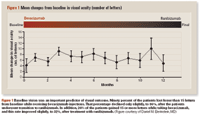Article
Transition from bevacizumab to ranibizumab yields no significant difference in visual outcomes for wet age-related macular degeneration
Improvements in visual outcomes remained stable in a group of patients with age-related macular degeneration who were switched from therapy with intravitreal bevacizumab (Avastin, Genentech) to intravitreal ranibizumab (Lucentis, Genentech).

Key Points
Chevy Chase, MD-Both off-label bevacizumab (Avastin, Genentech) and ranibizumab (Lucentis, Genentech) are effective in treatment of neovascular age-related macular degeneration (AMD), and no significant difference in visual outcomes is apparent when treatment was switched from bevacizumab to ranibizumab, said Daniel M. Berinstein, MD, a retina specialist with the Retina Group of Washington, Chevy Chase, MD.

When the FDA approved ranibizumab, patients who had been undergoing treatment with off-label bevacizumab were faced with the decision of whether to continue taking it or switch therapies, Dr. Berinstein said. Many of those patients opted to change to ranibizumab therapy, prompting Dr. Berinstein and colleagues to conduct a study to evaluate the efficacy of ranibizumab following treatment with bevacizumab. They reviewed the charts of 165 consecutive patients with AMD who underwent transition from one drug to the other.
About half of the patients had previous therapy, such as pegaptanib sodium (Macugen, [OSI]Eyetech/Pfizer), photodynamic therapy, or laser photocoagulation. Occult lesions were the most common type of lesion seen (75.6%), followed by minimally classic (13.3%) and predominantly classic (10.9%). Mean baseline VA was 20/157, and mean central retinal thickness was 295 µm. Sixty-seven percent of the patients were female, and the mean age was 82 years (range, 60 to 99 years).
Overall, patients received a mean of 6.4 injections (2.9 of bevacizumab and 3.5 of ranibizumab) and averaged about 100 days between the last injection of bevacizumab and the first injection of ranibizumab. The average interval between injections was 56 days (bevacizumab, 54; ranibizumab, 56). The overall follow-up was 384 days.
Looking at the entire treatment course, patients' conditions maintained a good response throughout the entire treatment course, and a significant decrease in mean central macular thickness was observed, Dr. Berinstein said.
The mean final central macular thickness was 242 versus 295 µm at baseline (p < 0.001).
Ninety percent of the patients lost fewer than 15 letters from baseline while receiving bevacizumab injections, he added; that percentage declined only slightly, to 86%, after the patients underwent transition to ranibizumab.
In addition, 26% of the patients gained 15 or more letters while taking bevacizumab, and this rate improved slightly, to 32%, after treatment with ranibizumab. The percentage of patients who had 20/40 or better vision was 9% at baseline, 12% after treatment with bevacizumab, and 20% by the end of the study.
"When one looks at the breakdown of the changes in vision, one saw [that when treatment was] started with bevacizumab, there was a significant improvement in VA. This was maintained with ranibizumab; however, it wasn't statistically significant," Dr. Berinstein said. Baseline vision, he added, was an important predictor of visual outcome.
Dr. Berinstein cautioned that his study was limited by its retrospective design, large variations in practice patterns among physicians who treated the patients, undefined parameters for number of injections, treatment interval, non-standardized vision and optical coherence tomography measurements, and short-term follow-up.
Newsletter
Don’t miss out—get Ophthalmology Times updates on the latest clinical advancements and expert interviews, straight to your inbox.
2 Commerce Drive
Cranbury, NJ 08512
All rights reserved.




